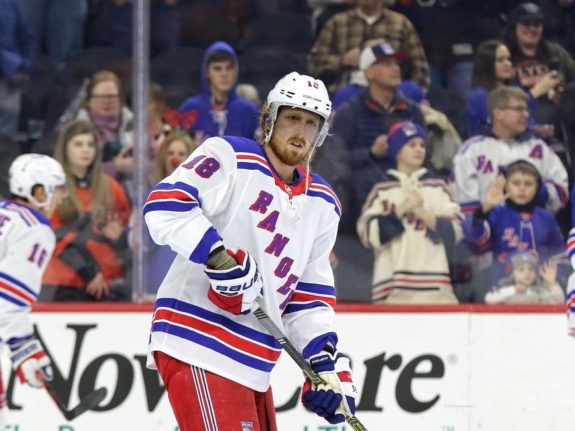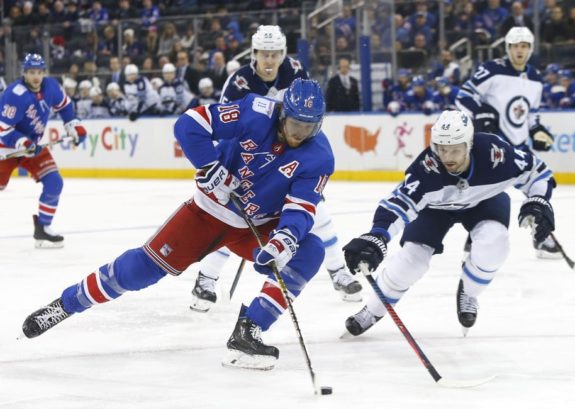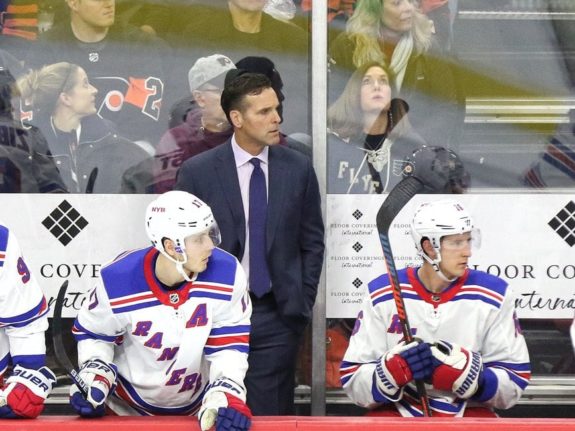Surely, Marc Staal knows the names by now. The host of hotshot New York Rangers defensive prospects supposedly on their way to take the left-side job of the career Blueshirt.
It’s a concept that got real Oct. 29, when for the first time in his 13-year career, Staal was made a healthy scratch. Rangers coach David Quinn, apparently somewhat displeased with Staal’s recent play and wanting to get one of the aforementioned youngsters, Ryan Lindgren, into the lineup, made what he called a “hard” decision to put Staal in street clothes.
Some saw that as an end of sorts for the 12th overall pick in the 2005 NHL Draft, with the highly regarded Lindgren, fellow prospect Libor Hajek, young veteran Brady Skjei and others eager to battle for the three left-side spots on the blue line going forward.

Expectation and reality often don’t meet, however, and one of the few holdovers from the team’s previous era of consistent contention has persevered and even at times thrived in managing to hold on to a regular role in 2019-20. The 33-year-old Staal missed a month in November and December due to an ankle infection that required surgery, but benefiting from a knee sprain to Hajek in early December that cost him five weeks and subsequently landed the 21-year-old in the minors to rediscover his game, Staal’s timing has actually proved to be pretty good this season – for a change.
With another year at a $5.7 million annual salary cap hit remaining on his contract after this season, the general feeling has largely been that Staal’s presence on the roster is anything but beneficial amidst the rebuilding project that’s nearly two years old. The Rangers will again face the difficult choice of whether to buy Staal out and add to an already-ugly ledger of dead money for 2020-21 – another tough decision that might nevertheless be made to get him out of the way.
Rangers Benefiting From Staal’s Veteran Presence
Yet Staal’s steady presence has proved more vital than advertised for a young defense corps that despite its precocious nature, is still finding its way in the NHL. The proud Staal’s unflashy game, naturally, renders those contributions largely overlooked.
“Obviously, I was upset and pretty frustrated,” Staal said of sitting out in October. “There weren’t a lot of talks (about what I needed to improve) and that’s why I was a little upset and frustrated by it. I was caught off guard that way.
“I think, internally, what it always comes down to is obviously (there is) a reason why they decided to take me out. So, just don’t give them that reason.” (From ‘Marc Staal Opens Up About Being Benched by Rangers, New York Post, 11/2/19)
Naysayers would tell you that Staal has no business being in the lineup for any reason. Putting aside some of the more indelicate descriptions of him such as “traffic cone,” advanced statistics paint Staal as a mostly ineffective defender, a relic whose slower, more physical game has been left behind by the modern high-speed NHL.

Those claims are not entirely without merit. Staal’s former defense partner Dan Girardi struggled with the speed of the current game toward the end with the Rangers, with the team executing a financially painful buyout of his deal after the 2016-17 season, with money from it remaining on their cap through 2022-23.
And it’s true that Staal’s type isn’t the future: Forward-like quickness and mobility from the back end are required elements now. Touting the toughness and grit of so-called “defensive defensemen” generally evokes eye rolls from current front-office personnel these days, that term cynically being seen as a delicate way of saying “he doesn’t skate well.”
Staal’s time with the Rangers is surely coming to an end, perhaps after this season rather than next. Yet, while advanced analytics have in the minds of many pushed aside plus-minus, formerly the standard for evaluating a player’s overall effectiveness, Staal has posted a plus-37 rating over the past six seasons. He was a plus player for all but one of those, including this season, during which he’s plus-6.
Believing that Staal has actually been a bad player during that extended period would seem to require a leap of faith that plus-minus is a wholly unreliable metric. By comparison, the 25-year-old Skjei, signed to a six-year, $31.5 million contract after the 2017-18 season to be a supposed future cornerstone, has struggled with consistency and is a minus-34 over the past three seasons – the qualifier being that most of that came in 2017-18 when he was minus-27.
In short, the Rangers might just need Staal’s throwback game for a little while longer as they work to build a new-age defense corps. Along with Skjei, Hajek and Lindgren on the left side, there’s K’Andre Miller and Yegor Rykov and Matthew Robertson and Tarmo Reunanen – other left-shot defenders whose names get bounced around like the Rangers’ future on the blue line.
Quinn Still Sees Value in Staal’s Game
At present, though, there aren’t three defensemen on the roster who Quinn trusts more than Staal to give him 18 dependable minutes per game on the left.
“He’s smart. When he’s playing well, he’s playing with an edge to his game,” Quinn told the Post. “He’s a strong defender; he’s got good gaps; he’s a good penalty killer. And again, he’s a guy who has been around for a long time. He’s as likeable a guy as there is; there’s a presence about him. Those are things that we need.”
Staal’s ill-advised six-year extension in Jan. 2015 was a regrettable parting gift handed out by former general manager Glen Sather at the end of his controversial 15-year tenure, a deal that now reminds fans of the more-than-occasional excesses of “Slats” during his time with the Blueshirts.
That contract does noticeably more than just potentially block lower-priced youngsters who need opportunities during the club’s period of rebuilding. Staal’s bloated cap hit is going play a role in the Rangers being unable to re-up all of their significant free agents after this season – even if they do choose to reap some savings on the deal via a buyout. It’s a perfect example of the long-term repercussions of bad contracts in the NHL’s salary cap era.

Yet the player who’s among four holdovers from the Stanley Cup Final season of 2013-14 is managing to provide some timely value, convoluted as it may be. He’s helping the only NHL team he’s ever known through the bumpy period of reconstruction, even as the Rangers begin the process of gradually phasing him out – with Staal knowing full well he won’t be around for the future on Broadway.
Not that too many people have noticed those contributions. And it’s not as if Staal would advertise them. That’s simply not the style of the quiet D-man who matched up with Sidney Crosby’s line during the 2013-14 playoffs, who with Anton Stralman formed the Rangers’ most reliable defense pairing during that run to the Final six years ago.
Will the Rangers miss elements of Staal’s presence? Likely. As with so much in life, they may not fully appreciate those until they’re gone. That time for No. 18 isn’t far off.
Get the latest New York Rangers news, rumors, commentary and analysis